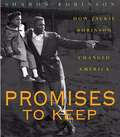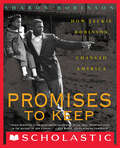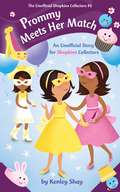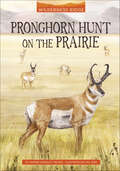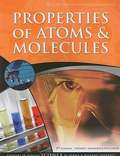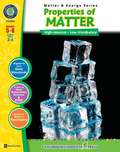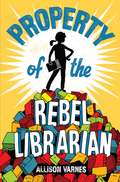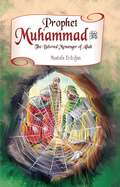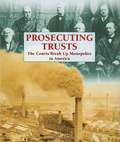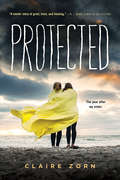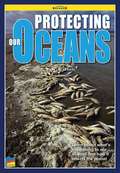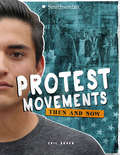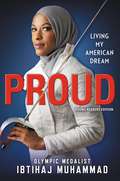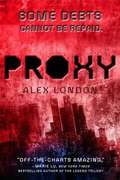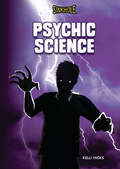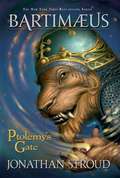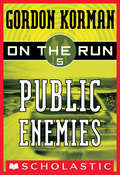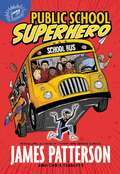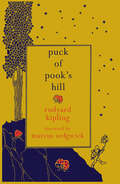- Table View
- List View
Promises I Made (Lies I Told #2)
by Michelle ZinkIn the thrilling sequel to Lies I Told, Grace learns that the most difficult thing about pulling off the perfect crime is living with the consequences. Fans of Ally Carter, Cecily von Ziegesar, and Gail Carriger will love this thrilling, high-stakes novel, which deftly explores the roles of identity and loyalty while offering a window into the world of the rich and fabulous.Grace Fontaine was trained to carry out perfect crimes. But when a mistake was made the night her family tried to execute their biggest heist yet, her world fell apart.Haunted by the way she betrayed her brother, her friends, and Logan—the only boy she's ever loved—Grace decides she must return to the place every thief knows you should avoid: the scene of the crime.Returning to Playa Hermosa as a wanted criminal is dangerous. But Grace has only one chance to make things right. To do it, she has to use everything she's been taught about the art of the con to hunt down the very people who trained her: the only family she's ever known.
Promises to Keep: How Jackie Robinson Changed America
by Sharon RobinsonA warm, intimate portrait of Jackie Robinson, America's sports icon, told from the unique perspective of a unique insider: his only daughter. Sharon Robinson shares memories of her famous father in this warm loving biography of the man who broke the color barrier in baseball. Jackie Robinson was an outstanding athlete, a devoted family man and a dedicated civil rights activist. The author explores the fascinating circumstances surrounding Jackie Robinson's breakthrough. She also tells the off-the-field story of Robinson's hard-won victories and the inspiring effect he had on his family, his community. . . his country! Includes never-before-published letters by Jackie Robinson, as well as photos from the Robinson family archives.
Promises to Keep: How Jackie Robinson Changed America
by Sharon RobinsonThe bestselling classic biography of Jackie Robinson, America's legendary baseball player and civil rights activist, told from the unique perspective of an insider: his only daughter.Sharon Robinson shares memories of her famous father in this warm loving biography of the man who broke the color barrier in baseball -- and taught his children that the only measure of life is the impact you have on others lives'.Promises to Keep is the story of Jackie Robinson's hard-won victories in baseball, business, politics, and civil rights. It looks at the inspiring effect the legendary Brooklyn Dodger had on his family, his community ... his country. Told from the unique perspective of Robinson's only daughter, this intimate and uplifting book includes photos from the Robinson family archives and family letters never published before.Jackie Robinson is one our great national heroes. Promises to Keep reminds us what made him a champion -- on and off the field!
Prommy Meets Her Match: An Unofficial Story for Shopkins Collectors (The Unofficial Shopkins Collectors #2)
by Kenley ShayMeet the Shopkins Kids Club, six friends who get together every week to trade and play with their favorite characters, collecting their own adventures along the way. Identical twins Ava and Bella look alike, and they often dress alike, too. But when the Shopkins Kids Club agrees to go to a costume party dressed as Shopkins characters, the two sisters disagree about what to wear. Ava wants to go in matching "prom” dresses inspired by Prommy--one sister in pink, and one in yellow. But Bella wants to wear a costume inspired by Betty Boot. Boots are more Bella’s style, especially since she dreams of taking horseback riding lessons one day. Bella doesn’t want to disappoint her sister, so her friends help her come up with a clever plan. Gabby will wear the yellow prom dress that matches Ava’s. And Bella can wear a cowgirl costume. If all the girls wear masks, they might even be able to pull this off without Ava finding out! But sneaking around is an awful lot of work. Can Bella find the courage to stop hiding and express her own style? Finding your own voice and friendship take center stage in the second Unofficial Shopkins Collectors story.
Pronghorn Hunt on the Prairie (Wilderness Ridge)
by Thomas Kingsley TroupeAdrina can’t wait to go pronghorn hunting in Wyoming with her dad and uncle. Her obnoxious cousin Frankie is coming too. She’s determined to ignore him as the family sets off on their trip. But soon, Frankie takes his jokes on Adrina way too far. Things get even worse when he misses a pronghorn and blames it on Adrina. Will the cousins be able to get along again and salvage the rest of the hunt?
Properties of Atoms and Molecules (God's Design for Chemistry and Ecology)
by Debbie Lawrence Richard LawrenceForming part of the series that covers complete chemistry and ecology curriculum for grades 3-8,this book focuses on atoms and molecules.
Properties of Matter (Matter & Energy)
by George GraybillThis book provides ready-to-use information and activities for remedial students in grades five to eight. Written to grade and using simplified language and vocabulary, science concepts are presented in a way that makes them more accessible to students and easier to understand. Comprised of reading passages, student activities and overhead transparencies, our resource can be used effectively for whole-class, small group and independent work.
Properties of Matter: Student Guide and Source Book
by National Science Resources CenterNIMAC-sourced textbook
Properties of Matter: Student Guide and Source Book
by National Science Resources CenterWhat is the meaning of the term "matter"? In this lesson, you will discuss the different meanings of thius word and how it is used in science. You will also do a circuit of eight inquiries on the properties of matter. These inquiries are designed to get you thinking about what matter is, what its properties are, and how it behaves.
Property of the Rebel Librarian
by Allison VarnesCelebrate the freedom to read with this timely, empowering middle-grade debut in the spirit of The View from Saturday or Frindle.When twelve-year-old June Harper's parents discover what they deem an inappropriate library book, they take strict parenting to a whole new level. And everything June loves about Dogwood Middle School unravels: librarian Ms. Bradshaw is suspended, an author appearance is canceled, the library is gutted, and all books on the premises must have administrative approval. But June can't give up books . . . and she realizes she doesn't have to when she spies a Little Free Library on her walk to school. As the rules become stricter at school and at home, June keeps turning the pages of the banned books that continue to appear in the little library. It's a delicious secret . . . and one she can't keep to herself. June starts a banned book library of her own in an abandoned locker at school. The risks grow alongside her library's popularity, and a movement begins at Dogwood Middle--a movement that, if exposed, could destroy her. But if it's powerful enough, maybe it can save Ms. Bradshaw and all that she represents: the freedom to read.Equal parts fun and empowering, this novel explores censorship, freedom of speech, and activism. For any kid who doesn't believe one person can effect change...and for all the kids who already know they can!
Prophet Muhammad: The Beloved Messenger of Allah
by Mustafa ErdoganThis book is a short summary of Prophet Muhammad's life for the younger readers. It presents major milestones in the life of the Prophet with an easy to understand style in line with the mainstream Islamic tradition. It is also a great bedtime story book for interested families who want to read from the life of the Prophet.
Prosecuting Trusts: The Courts Break Up Monopolies In America (Primary Sources Of The Progressive Movement Series)
by Bernadette BrexelBig business in the mid-1800s worked to eliminate competition by purchasing smaller businesses or undercutting their prices. They created trusts, or groups of businesses under one giant merging corporation, affecting both small businesses and farmers. As this book effectively addresses, there were calls for business reform by the 1890s. Laws like the Sherman Antitrust Act sought to redress the problems of big business, but it was through the efforts of President Theodore Roosevelt that the federal government went after these trusts; those actions earned Roosevelt the reputation as a trust buster.
Protected
by Claire ZornAn inspiring and achingly honest story of a girl with the courage to endure, hope, and even heal in the face of unimaginable tragedy, perfect for fans of Sarah Dessen's Just Listen. I have three months left to call Katie my older sister. Then the gap will close and I will pass her. I will get older. But Katie will always be fifteen, eleven months and twenty-one days old. Hannah has survived high school by putting up walls. At first, they were meant to protect her from the relentless bullying that no one would defend her from, not even her popular older sister, Katie. Then Katie died, and, in a cruel twist of fate, Hannah's daily torment abruptly stopped. Now the walls try to shut it all out-the grief, the loneliness, and the harsh truth that Katie's death has somehow improved Hannah's life. Then something happens that Hannah couldn't have predicted-friendship comes knocking in the form of new student Josh Chamberlain. Hannah has never been so desperate for connection. But if this isn't for real, if it's just another joke, Hannah's not sure she can take it. Praise for Protected:"Zorn shows the devastating effects of bullying while affectingly tracing Hannah's spiritual journey, coming to terms with truths she doesn't want to face and learning how to trust. " —Publishers Weekly, Starred Review"Though the book tackles important issues, it reaches far beyond these flash points into a fully developed exploration of the aftermath of tragedy through strong characterization and genuine emotional appeal."-Kirkus, Starred Review
Protecting Our Oceans
by Jeanette LeardiLearn about the marine life that lives in the world's oceans and how people can protect these habitats by keeping the ocean clean.
Protector of the Small Quartet
by Tamora PierceTamora Pierce's New York Times bestselling series The Protector of the Small Quartet is available now in one ebook collection, including First Test, Page, Squire, and Lady Knight. In the medieval and fantastic realm of Tortall, Keladry of Mindelan (known as Kel) is the first girl to take advantage of the decree that permits women to train for knighthood. But not everyone in Tortall believes a woman is up to the task, and Kel faces harsh discrimination. With unparalleled determination and a knack for leadership, she captures the hearts of her peers and proves that she is not a girl to underestimate! From probationary Page to Lady Knight, Kel's challenging journey is filled with friendship, romance, and unforgettable adventure.
Protest Movements: Then and Now (America: 50 Years of Change)
by Eric BraunDiscusses the main concerns of the protest movements of the 1960s and how those have evolved since; what's changed for the better, what might be worse, and where do we go from here.
Proud (Young Readers Edition): Living My American Dream
by Ibtihaj MuhammadThe inspiring all-American story of faith, family, hard work, and perseverance by Olympic fencer, activist, and Time"100 Most Influential People" honoree Ibtihaj MuhammadAt the 2016 Rio Olympics, Ibtihaj Muhammad smashed barriers as the first American to compete wearing hijab, and made history as the first Muslim-American woman to medal. But it wasn't an easy road--in a sport most popular among wealthy white people, Ibtihaj often felt out of place. Ibtihaj was fast, hardworking, and devoted to her faith, but rivals and teammates (as well as coaches and officials) pointed out her differences, insisting she would never succeed. Yet Ibtihaj powered on. Her inspiring journey from a young outsider to an Olympic hero is a relatable, memorable, and uniquely American tale of hard work, determination, and self-reliance.
Proxy
by Alex LondonSyd's life is not his own. As a proxy he must to pay for someone else's crimes. When his patron Knox crashes a car and kills someone, Syd is branded and sentenced to death. The boys realize the only way to beat the system is to save each other so they flee. <p><p>The ensuing cross-country chase will uncover a secret society of rebels, test the boys' resolve, and shine a blinding light onto a world of those who owe and those who pay.
Psychic Science (Sinkhole)
by Kelli HicksAnna and Caleb have been friends since kindergarten, but their beliefs have pushed them apart. Anna is president of the science club and focused on getting into the best college. Caleb is fascinated by the supernatural and stretches the truth to get more views on social media. When a purple mist emerges near Foggy Creek's sinkhole, people and animals start acting like zombies. Can Anna and Caleb put aside their differences to save Foggy Creek before it's too late?
Ptolemy's Gate (A Bartimaeus Novel #3)
by Jonathan StroudIn the third book of the series, Bartimaeus, Nathaniel, and Kitty must test the limits of this world, question the deepest parts of themselves -- and trust one another if they hope to survive. Includes a preview chapter from The Ring of Solomon, a Bartimaeus novel.
Public Enemies: Public Enemies (On the Run #5)
by Gordon KormanThe Falconer siblings come one step closer to freeing their parents from jail in this fifth installment of the thrilling Gordon Korman series.Aiden and Meg Falconer have been crossing the country as fugitives in order to prove their parents didn't commit a crime. They've been chased from state to state by the FBI . . . and by a killer they know only as Hairless Joe. Now Hairless Joe is getting closer than ever -- and the Falconers are getting even closer than that to the truth.
Public School Superhero
by James Patterson Chris Tebbetts Cory ThomasKenny Wright is a kid with a secret identity. In his mind, he's Stainlezz Steel, super-powered defender of the weak. In reality, he's a chess club devotee known as a "Grandma's Boy," a label that makes him an easy target for bullies. Kenny wants to bring a little more Steel to the real world, but the question is: can he recognize his own true strength before peer pressure forces him to make the worst choice of his life?Featuring more than 150 pieces of line art and comic-style sequences, James Patterson's newest illustrated novel is a genuinely funny yet poignant look at middle school in a challenging urban setting, where a kid's life can depend on the everyday decisions he makes.
Public Speaking (Merit Badge Ser.)
by Boy Scouts of AmericaThis book outlines requirements for pursuing a merit badge in public speaking.
Puck of Pook's Hill
by Rudyard Kipling Marcus SedgwickFrom the author of The Jungle Book comes a magical fantasy story, rich in historical detail and filled with intrigue and excitementUna and Dan, reciting Shakespeare on a summer's evening in rural Sussex, unwittingly summon the elf Puck. They are taken on a fantastic journey through Britain's past, their magical companion plucking from history an array of fascinating characters for them to meet: Parnesius, a Roman centurion who manned Hadrian's wall; Wayland, a Saxon warrior and blacksmith; Sir Richard, a Norman knight who made an extraordinary journey to Africa; and many others. Each offers a story from his own life, mixing war and politics with adventure and intrigue. Each is rich with historical detail. One of the great classics of children's literature, Puck of Pook's Hill is by turns a fantastical story of magical otherness and a compelling exploration of history. A runaway success on first publication, it still has the power to excite children and their parents alike.
Puck of Pook's Hill
by Rudyard KiplingClassic Kipling children's story. According to Wikipedia: "Joseph Rudyard Kipling (1865 - 1936) was an English author and poet. Born in Bombay, British India (now Mumbai), he is best known for his works The Jungle Book (1894) and Rikki-Tikki-Tavi (1902), his novel, Kim (1901); his poems, including Mandalay (1890), Gunga Din (1890), If- (1910); and his many short stories, including The Man Who Would Be King (1888). He is regarded as a major "innovator in the art of the short story"; his children's books are enduring classics of children's literature; and his best works speak to a versatile and luminous narrative gift. Kipling was one of the most popular writers in English, in both prose and verse, in the late 19th and early 20th centuries. [2] The author Henry James said of him: "Kipling strikes me personally as the most complete man of genius (as distinct from fine intelligence) that I have ever known. " In 1907, he was awarded the Nobel Prize in Literature, making him the first English language writer to receive the prize, and to date he remains its youngest recipient. Among other honours, he was sounded out for the British Poet Laureateship and on several occasions for a knighthood, all of which he declined.

